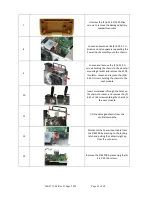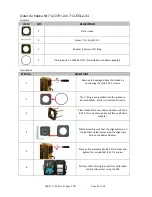
906-0731-04 Rev. B Sept. 2012
Page 11 of 68
a procedure for the cleaning and disinfection of its medical equipment and that these
procedures be consulted for further guidance.
3.
Care must be taken to prevent liquids from entering the ventilator. Never submerge the
ventilator and avoid using excessive amounts of water that might enter the unit.
4.
Never use abrasives or chlorinated hydrocarbon based cleansers when cleaning the ventilator,
they will damage the plastic and interface lens.
5.
Always follow the decontamination procedures specified by the local Incident Command Safety
Officer.
6.
Equipment should be cleaned and decontaminated as soon as possible after use. Personnel
should always wear the appropriate Personal Protective Equipment while decontaminating
equipment.
7.
The ventilator’s outer case should be cleaned with a damp soapy cloth and thoroughly dried
with a lint-free cloth. Make sure that all exposed surfaces are cleaned and dried.
8.
For general decontamination/cleaning situations, a 10% bleach solution applied with a damp
cloth is an effective decontaminant that can be used. Since the potential amount of
contaminants that our ventilators might be exposed to is so large, it is difficult to provide an
appropriate cleaning method for each type of exposure. An effective cleaning agent for one
type of exposure may not be effective with another and cleaning and sterilizing practices may
vary between institutions. Impact Instrumentation, Inc. suggests that each facility have in place
a procedure for the cleaning and disinfection of its medical equipment and that these
procedures be consulted for further guidance.
9.
Care must be taken to prevent liquids from entering the ventilator. Never submerge the
ventilator and avoid using excessive amounts of water that might enter the unit.
10.
Never use abrasives or chlorinated hydrocarbon based cleansers when cleaning the ventilator,
they will damage the plastic and interface lens.
Removable Foam Filter Replacement
Removable Foam Filter:
The Removable Foam Filter is located on the right side of the ventilator. It should
be inspected and replaced if needed every 1,000 hours of operation or more frequently if used in dusty
environments. Remove the filter using a pair of tweezers or similar tool. Examine the filter for dirt, lint, or
general wear. Replace if necessary (Part # 465-0028-00). DO NOT attempt to clean this filter.
CAUTION!
Do not operate the compressor without a filter in place.
Fresh Gas/Emergency Air Intake Disk Filter Replacement
Fresh Gas/Emergency Air Intake Disk Filter:
The Fresh Gas/Emergency Air Intake Disk Filter (Part #465-
0027-00) is located behind the Removable Foam Filter. This filter provides a second level of filtration to the
ambient air that is delivered to the patient. This filter must be checked periodically and replaced when
necessary. The device triggers an alarm when the combination of Removable Foam Filter and Fresh
Gas/Emergency Air Intake Disk Filter become dirty. This alarm signifies that the device is still able to deliver
the correct tidal volume but one or more of its filters need replacement. The Fresh Gas/Emergency Air
Intake Disk Filter can be visually inspected after the Removable Foam Filter is removed. If the filter appears
discolored it must be replaced. See Appendix 5 in the Operation Manual: Internal Filter Change/Insertion.
CAUTION!
There are no user serviceable parts except the filter components described above.
CAUTION!
When used in dusty/dirty environments the foam and disk filters should be checked, and
replaced as needed. This will prevent particle build up on the transducer screen and the need to take the
unit out of service for maintenance by a biomedical technician.












































